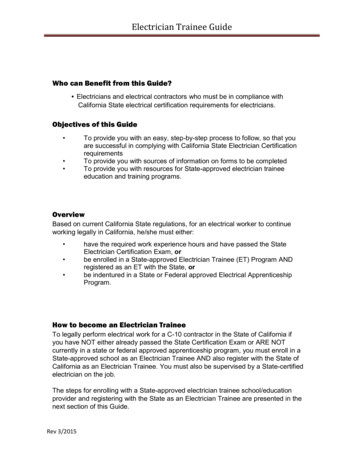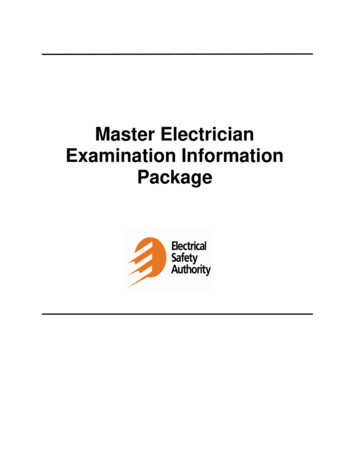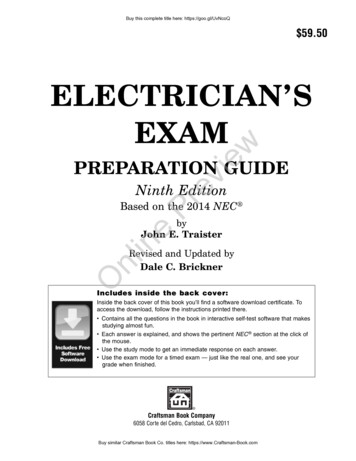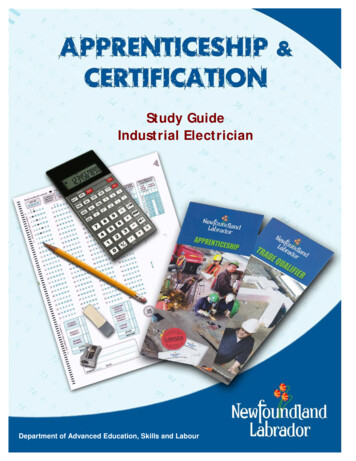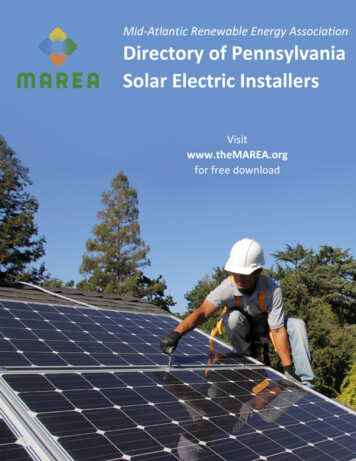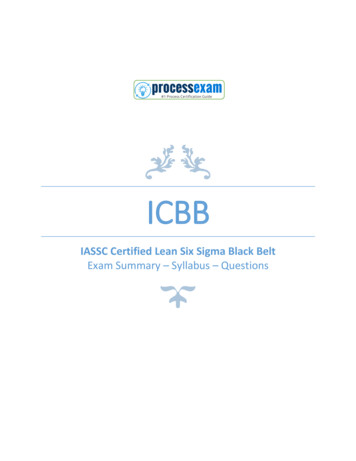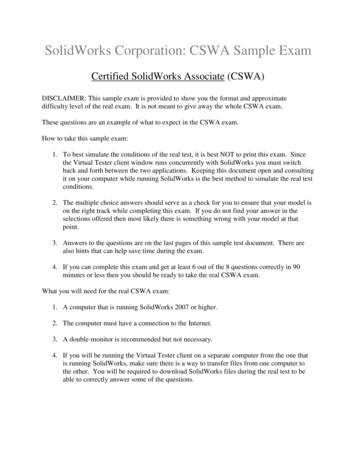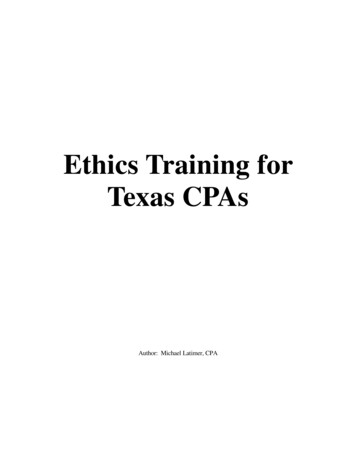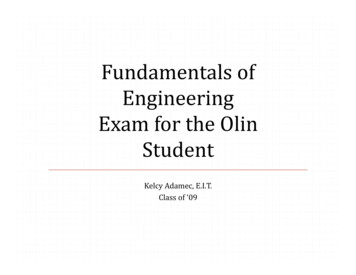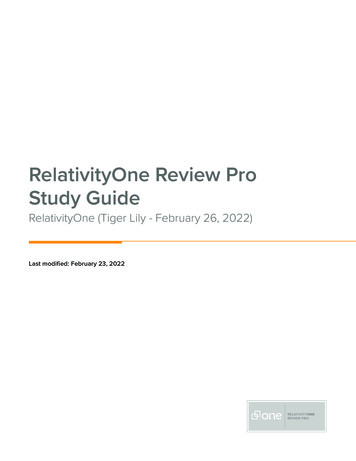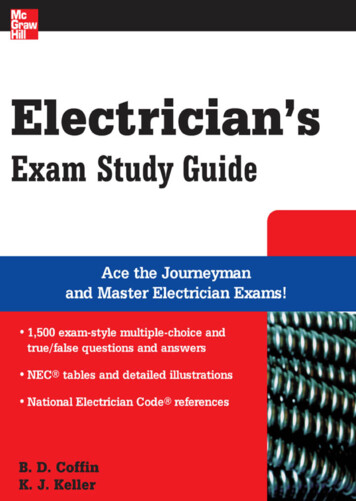
Transcription
ELECTRICIAN’S EXAMSTUDY GUIDE
About the AuthorsB. D. COFFIN is a Master Electrician and Fire Alarm Installation Trainer with over 30 years of experiencein the residential, commercial, and industrial markets.K. J. KELLER is the CAD Designer, Safety & Compliance Director, and Project Coordinator for a leadingNew England electrical contractor. She has over 30 years of experience in residential and commercial construction.Copyright 2007 by The McGraw-Hill Companies, Inc. Click here for terms of use.
ELECTRICIAN’S EXAMSTUDY GUIDEB. D. Coffin and K. J. KellerNew YorkChicago San Francisco Lisbon London MadridMexico City Milan New Delhi San Juan SeoulSingapore Sydney Toronto
Copyright 2007 by The McGraw-Hill Companies, Inc. All rights reserved. Manufactured in the United States of America. Except as permittedunder the United States Copyright Act of 1976, no part of this publication may be reproduced or distributed in any form or by any means, or storedin a database or retrieval system, without the prior written permission of the publisher.0-07-159476-0The material in this eBook also appears in the print version of this title: 0-07-148930-4.All trademarks are trademarks of their respective owners. Rather than put a trademark symbol after every occurrence of a trademarked name, weuse names in an editorial fashion only, and to the benefit of the trademark owner, with no intention of infringement of the trademark. Where suchdesignations appear in this book, they have been printed with initial caps.McGraw-Hill eBooks are available at special quantity discounts to use as premiums and sales promotions, or for use in corporate training programs.For more information, please contact George Hoare, Special Sales, at george hoare@mcgraw-hill.com or (212) 904-4069.TERMS OF USEThis is a copyrighted work and The McGraw-Hill Companies, Inc. (“McGraw-Hill”) and its licensors reserve all rights in and to the work. Use ofthis work is subject to these terms. Except as permitted under the Copyright Act of 1976 and the right to store and retrieve one copy of the work,you may not decompile, disassemble, reverse engineer, reproduce, modify, create derivative works based upon, transmit, distribute, disseminate,sell, publish or sublicense the work or any part of it without McGraw-Hill’s prior consent. You may use the work for your own noncommercialand personal use; any other use of the work is strictly prohibited. Your right to use the work may be terminated if you fail to comply with theseterms.THE WORK IS PROVIDED “AS IS.” McGRAW-HILL AND ITS LICENSORS MAKE NO GUARANTEES OR WARRANTIES AS TO THEACCURACY, ADEQUACY OR COMPLETENESS OF OR RESULTS TO BE OBTAINED FROM USING THE WORK, INCLUDING ANYINFORMATION THAT CAN BE ACCESSED THROUGH THE WORK VIA HYPERLINK OR OTHERWISE, AND EXPRESSLY DISCLAIMANY WARRANTY, EXPRESS OR IMPLIED, INCLUDING BUT NOT LIMITED TO IMPLIED WARRANTIES OF MERCHANTABILITYOR FITNESS FOR A PARTICULAR PURPOSE. McGraw-Hill and its licensors do not warrant or guarantee that the functions contained in thework will meet your requirements or that its operation will be uninterrupted or error free. Neither McGraw-Hill nor its licensors shall be liable toyou or anyone else for any inaccuracy, error or omission, regardless of cause, in the work or for any damages resulting therefrom. McGraw-Hillhas no responsibility for the content of any information accessed through the work. Under no circumstances shall McGraw-Hill and/or itslicensors be liable for any indirect, incidental, special, punitive, consequential or similar damages that result from the use of or inability to use thework, even if any of them has been advised of the possibility of such damages. This limitation of liability shall apply to any claim or causewhatsoever whether such claim or cause arises in contract, tort or otherwise.DOI: 10.1036/0071489304
ProfessionalWant to learn more?We hope you enjoy thisMcGraw-Hill eBook! Ifyou’d like more information about this book,its author, or related books and websites,please click here.
For more information about this title, click hereContentsAcknowledgments and Dedications . . . . . . . . . . . . . . . . . . . . . . . . . . . . . . . . . . . . . . . . . . viiiPreface . . . . . . . . . . . . . . . . . . . . . . . . . . . . . . . . . . . . . . . . . . . . . . . . . . . . . . . . . . . . . . . . . . . . . . . . . . ixUnderstanding the NEC . . . . . . . . . . . . . . . . . . . . . . . . . . . . . . . . . . . . . . . . . . . . . . . . . . . . . . . xChapter 1ARTICLES 90 THROUGH 110 . . . . . . . . . . . . . . . . . . . . . . . . . . . . . . . . . . . . . . . 1Quiz 1—Articles 90 and 100 . . . . . . . . . . . . . . . . . . . . . . . . . . . . . . . . . . . . . . . . . . . . . . . . . . . . . . . . . 10Quiz 2—Article 110 . . . . . . . . . . . . . . . . . . . . . . . . . . . . . . . . . . . . . . . . . . . . . . . . . . . . . . . . . . . . . . . 14Quiz 3—True/False . . . . . . . . . . . . . . . . . . . . . . . . . . . . . . . . . . . . . . . . . . . . . . . . . . . . . . . . . . . . . . . 18Answers . . . . . . . . . . . . . . . . . . . . . . . . . . . . . . . . . . . . . . . . . . . . . . . . . . . . . . . . . . . . . . . . . . . . . . . . . 21Chapter 2WIRING REQUIREMENTS AND PROTECTION . . . . . . . . . . . . . . . . . . 23Quiz 1—Principles-Article 200 . . . . . . . . . . . . . . . . . . . . . . . . . . . . . . . . . . . . . . . . . . . . . . . . . . . . . . .28Quiz 2—Review-Article 200 . . . . . . . . . . . . . . . . . . . . . . . . . . . . . . . . . . . . . . . . . . . . . . . . . . . . . . . . .31Quiz 3—True/False . . . . . . . . . . . . . . . . . . . . . . . . . . . . . . . . . . . . . . . . . . . . . . . . . . . . . . . . . . . . . . . .35Quiz 4—Multiple Choice . . . . . . . . . . . . . . . . . . . . . . . . . . . . . . . . . . . . . . . . . . . . . . . . . . . . . . . . . . . .40Answers . . . . . . . . . . . . . . . . . . . . . . . . . . . . . . . . . . . . . . . . . . . . . . . . . . . . . . . . . . . . . . . . . . . . . . . . . .49Chapter 3WIRING METHODS AND MATERIALS . . . . . . . . . . . . . . . . . . . . . . . . . . . 55Quiz 1—Article 300 . . . . . . . . . . . . . . . . . . . . . . . . . . . . . . . . . . . . . . . . . . . . . . . . . . . . . . . . . . . . . . . .62Quiz 2—Comprehensive Test-NEC Chapters 1 through 3 . . . . . . . . . . . . . . . . . . . . . . . . . . . . . . . . 65Quiz 3—True/False . . . . . . . . . . . . . . . . . . . . . . . . . . . . . . . . . . . . . . . . . . . . . . . . . . . . . . . . . . . . . . . .69Quiz 4—Multiple Choice . . . . . . . . . . . . . . . . . . . . . . . . . . . . . . . . . . . . . . . . . . . . . . . . . . . . . . . . . . . .78Answers . . . . . . . . . . . . . . . . . . . . . . . . . . . . . . . . . . . . . . . . . . . . . . . . . . . . . . . . . . . . . . . . . . . . . . . . . 95Chapter 4EQUIPMENT FOR GENERAL USE . . . . . . . . . . . . . . . . . . . . . . . . . . . . . . . 101Quiz 1—Article 400 . . . . . . . . . . . . . . . . . . . . . . . . . . . . . . . . . . . . . . . . . . . . . . . . . . . . . . . . . . . . . . 110Answers . . . . . . . . . . . . . . . . . . . . . . . . . . . . . . . . . . . . . . . . . . . . . . . . . . . . . . . . . . . . . . . . . . . . . . . . 117v
viElectrician’s Exam Study GuideChapter 5SPECIAL OCCUPANCIES AND CLASSIFICATIONS . . . . . . . . . . . . 119Quiz 1 . . . . . . . . . . . . . . . . . . . . . . . . . . . . . . . . . . . . . . . . . . . . . . . . . . . . . . . . . . . . . . . . . . . . . . . . . 129Quiz 2—Classifications . . . . . . . . . . . . . . . . . . . . . . . . . . . . . . . . . . . . . . . . . . . . . . . . . . . . . . . . . . . . 133Answers . . . . . . . . . . . . . . . . . . . . . . . . . . . . . . . . . . . . . . . . . . . . . . . . . . . . . . . . . . . . . . . . . . . . . . . . 136Chapter 6SPECIAL EQUIPMENT . . . . . . . . . . . . . . . . . . . . . . . . . . . . . . . . . . . . . . . . . . . . 139Quiz 1 . . . . . . . . . . . . . . . . . . . . . . . . . . . . . . . . . . . . . . . . . . . . . . . . . . . . . . . . . . . . . . . . . . . . . . . . . 149Quiz 2 . . . . . . . . . . . . . . . . . . . . . . . . . . . . . . . . . . . . . . . . . . . . . . . . . . . . . . . . . . . . . . . . . . . . . . . . . 166Answers . . . . . . . . . . . . . . . . . . . . . . . . . . . . . . . . . . . . . . . . . . . . . . . . . . . . . . . . . . . . . . . . . . . . . . . . 174Chapter 7SPECIAL CONDITIONS . . . . . . . . . . . . . . . . . . . . . . . . . . . . . . . . . . . . . . . . . . . 177Quiz 1 . . . . . . . . . . . . . . . . . . . . . . . . . . . . . . . . . . . . . . . . . . . . . . . . . . . . . . . . . . . . . . . . . . . . . . . . . 183Quiz 2 . . . . . . . . . . . . . . . . . . . . . . . . . . . . . . . . . . . . . . . . . . . . . . . . . . . . . . . . . . . . . . . . . . . . . . . . . 186Answers . . . . . . . . . . . . . . . . . . . . . . . . . . . . . . . . . . . . . . . . . . . . . . . . . . . . . . . . . . . . . . . . . . . . . . . . 197Chapter 8COMMUNICATIONS . . . . . . . . . . . . . . . . . . . . . . . . . . . . . . . . . . . . . . . . . . . . . . 199Quiz 1 . . . . . . . . . . . . . . . . . . . . . . . . . . . . . . . . . . . . . . . . . . . . . . . . . . . . . . . . . . . . . . . . . . . . . . . . . 204Quiz 2 . . . . . . . . . . . . . . . . . . . . . . . . . . . . . . . . . . . . . . . . . . . . . . . . . . . . . . . . . . . . . . . . . . . . . . . . . 212Answers . . . . . . . . . . . . . . . . . . . . . . . . . . . . . . . . . . . . . . . . . . . . . . . . . . . . . . . . . . . . . . . . . . . . . . . . 217Chapter 9TABLES, ANNEXES, AND EXAMPLES . . . . . . . . . . . . . . . . . . . . . . . . . . 219Quiz 1—Review . . . . . . . . . . . . . . . . . . . . . . . . . . . . . . . . . . . . . . . . . . . . . . . . . . . . . . . . . . . . . . . . . 236Quiz 2 . . . . . . . . . . . . . . . . . . . . . . . . . . . . . . . . . . . . . . . . . . . . . . . . . . . . . . . . . . . . . . . . . . . . . . . . . 238Quiz 3 . . . . . . . . . . . . . . . . . . . . . . . . . . . . . . . . . . . . . . . . . . . . . . . . . . . . . . . . . . . . . . . . . . . . . . . . . 245Answers . . . . . . . . . . . . . . . . . . . . . . . . . . . . . . . . . . . . . . . . . . . . . . . . . . . . . . . . . . . . . . . . . . . . . . . . 253Chapter 10MATH CALCULATIONS AND BASIC ELECTRICAL THEORY 257Timed Math Test . . . . . . . . . . . . . . . . . . . . . . . . . . . . . . . . . . . . . . . . . . . . . . . . . . . . . . . . . . . . . . . . 265Answers . . . . . . . . . . . . . . . . . . . . . . . . . . . . . . . . . . . . . . . . . . . . . . . . . . . . . . . . . . . . . . . . . . . . . . . . 269Chapter 11REVIEW AND APPLYING PRINCIPLES . . . . . . . . . . . . . . . . . . . . . . . . 271Quiz 1—Basic Electrical Principles . . . . . . . . . . . . . . . . . . . . . . . . . . . . . . . . . . . . . . . . . . . . . . . . . . . 281Answers . . . . . . . . . . . . . . . . . . . . . . . . . . . . . . . . . . . . . . . . . . . . . . . . . . . . . . . . . . . . . . . . . . . . . . . . 292Chapter 12MASTER ELECTRICIAN SKILLS . . . . . . . . . . . . . . . . . . . . . . . . . . . . . . . . 293Master Level Quiz . . . . . . . . . . . . . . . . . . . . . . . . . . . . . . . . . . . . . . . . . . . . . . . . . . . . . . . . . . . . . . . . 298Answers . . . . . . . . . . . . . . . . . . . . . . . . . . . . . . . . . . . . . . . . . . . . . . . . . . . . . . . . . . . . . . . . . . . . . . . . 303
ContentsChapter 13viiTIMED TEST 1 . . . . . . . . . . . . . . . . . . . . . . . . . . . . . . . . . . . . . . . . . . . . . . . . . . . 305Timed Test 1 . . . . . . . . . . . . . . . . . . . . . . . . . . . . . . . . . . . . . . . . . . . . . . . . . . . . . . . . . . . . . . . . . . . . 306Answers . . . . . . . . . . . . . . . . . . . . . . . . . . . . . . . . . . . . . . . . . . . . . . . . . . . . . . . . . . . . . . . . . . . . . . . . 314Chapter 14TIMED TEST 2 . . . . . . . . . . . . . . . . . . . . . . . . . . . . . . . . . . . . . . . . . . . . . . . . . . . 317Timed Test 2 . . . . . . . . . . . . . . . . . . . . . . . . . . . . . . . . . . . . . . . . . . . . . . . . . . . . . . . . . . . . . . . . . . . . 319Answers . . . . . . . . . . . . . . . . . . . . . . . . . . . . . . . . . . . . . . . . . . . . . . . . . . . . . . . . . . . . . . . . . . . . . . . . 326Chapter 15TIMED TEST 3 . . . . . . . . . . . . . . . . . . . . . . . . . . . . . . . . . . . . . . . . . . . . . . . . . . . 329Timed Test 3 . . . . . . . . . . . . . . . . . . . . . . . . . . . . . . . . . . . . . . . . . . . . . . . . . . . . . . . . . . . . . . . . . . . . 331Answers . . . . . . . . . . . . . . . . . . . . . . . . . . . . . . . . . . . . . . . . . . . . . . . . . . . . . . . . . . . . . . . . . . . . . . . . 347Chapter 16CLOSED BOOK EXAM . . . . . . . . . . . . . . . . . . . . . . . . . . . . . . . . . . . . . . . . . . . 351Closed Book Exam . . . . . . . . . . . . . . . . . . . . . . . . . . . . . . . . . . . . . . . . . . . . . . . . . . . . . . . . . . . . . . . 352Answers . . . . . . . . . . . . . . . . . . . . . . . . . . . . . . . . . . . . . . . . . . . . . . . . . . . . . . . . . . . . . . . . . . . . . . . . 366Chapter 17TECHNIQUES FOR STUDYING AND TAKING YOUR TEST . 367Studying for the Exam . . . . . . . . . . . . . . . . . . . . . . . . . . . . . . . . . . . . . . . . . . . . . . . . . . . . . . . . . . . . 368Taking Your Exam . . . . . . . . . . . . . . . . . . . . . . . . . . . . . . . . . . . . . . . . . . . . . . . . . . . . . . . . . . . . . . . 369
Acknowledgmentsand DedicationsI would like to acknowledge my employers. Without their training, support, and the opportunities they havegiven me, I would not know half of what I know today.—B. D. CoffinI would like to dedicate my contributions to this book to my children, Afton and Adam; my shining star andmy lighthouse. Their energy, love, and enthusiasm are what make everything I do worthwhile. I would alsolike to thank Taven for ever reminding me that, in time, anything is possible.—K. J. KellerWe would both like to thank the National Fire Protection Association for permission to reference the 2005NEC standards and for allowing us to reprint materials from the 2005 National Electrical Code book forthe benefit of our readers.National Electrical Code and NEC are registered trademarks of the National Fire Protection Association, Inc., Quincy, MA 02169.viiiCopyright 2007 by The McGraw-Hill Companies, Inc. Click here for terms of use.
PrefaceThis book has been written for experienced electricians who plan to take a state required exam in order toobtain a Journeyman or Master electrician’s license. We are going on the assumption that you are enteringthis phase of your career with a basic understanding of the electrical trade and electrical theory. One thingyou need to know before you take your licensing exam is that your hands-on experience in the field will notbe enough to get you a passing grade.Many of the questions on licensing exams are based on the National Electrical Code , so you will needto have a current NEC book to study and use for reference. Some states will allow you to refer to your codebook during the test, while others give “no book” or “closed book” exams. Test centers which allow openbook exams will only permit you to bring your NEC code book, even though a percentage of the test questions will be on electrical theory, controls and other principals used in the safe installation of electrical work.All of the tests are timed and require a testing fee. We know your time and money are valuable, so our goalis to provide you with the study tools, references, and examples you will need to thoroughly prepare yourself to pass your licensing exam.There are over 1,500 sample test questions presented in this book in a manner which closely resemblesthe types of questions you may find on the licensing exam. There are True/False and multiple-choice questions, just like on the real test. In order to increase your understanding of the questions, there are answersheets which include cross-references to the precise article and section of the NEC from which the question is taken.The text material at the beginning of each chapter also explains applicable articles and requirements ina manner which makes even the most complicated code standards easier to understand.There are numerous Test Tips throughout the book which explain how to arrive at the correct answers.Additionally, there are Code Updates in each chapter which clarify changes in the 2005 NEC , so that youcan be certain that the material you are studying is current and accurate. The NEC covers specialized installation requirements, many of which you may not have performed as an electrician, such as working inhazardous locations, or wiring for hospitals or low-voltage communications systems. Lack of trade experience can be compensated for by studying the NEC and by taking mock exams. That’s why there are practice exams at the end of the book, so that you can get a feel for the type of material you might expect to findwhen you take your actual licensing exam.The purpose of this book is to help you develop your ability to understand how licensing exam questionsmay be written, which standards apply, and how to arrive at the most correct answers in order to receive apassing grade.B. D. CoffinK. J. KellerixCopyright 2007 by The McGraw-Hill Companies, Inc. Click here for terms of use.
This page intentionally left blank
Understandingthe NEC When you started working in the electrical industry, all you probably had to do was apply for a helper or associate license and pay a minimal fee to process the application. Now you have worked for thousands ofhours and have acquired extensive hands-on experience. You are ready to move up to the next level and become a journeyman electrician, or perhaps its time for you to go into business for yourself and become amaster electrician. The first thing you need to do is to contact your state licensing organization and determine the requirements for licensure in your area. Only Illinois, Indiana, Kansas, Kentucky, Missouri, NewYork, and Pennsylvania do not expect you be licensed at the state level. Most states require that you havecompleted a specific number of hours of service as an apprentice and some form of study program. Oftenthis means that you cannot even consider getting your license unless you have at least 8000 hours of documented experience and that you have satisfactorily completed a 45-hour current National Electric Code course. Many locations require completion of state-approved trade-related courses with 225 or more credithours or graduation from an accredited regional vocational program. Finally, almost every state in the country requires that you take and pass a written test in order to be licensed to perform electrical work withoutsupervision. This test is composed of questions taken directly from and the National Electrical Code .The National Fire Protection Association, Inc., known by the acronym NFPA , develops and publishesthe National Electrical Code (NEC ), which is a compilation of codes and standards for the InternationalElectrical Code. Each section of the NEC falls under NFPA 70 and has been developed through a committee process to establish standards for electrical installations to reduce the risk of hazards. The NationalElectrical Code is set up by articles that categorize general areas of electrical work, and each article is subdivided into sections that detail standards for specific aspects of that work.All of the written licensing tests are timed, based on the NEC codes, and many allow you three hours tocomplete the questions. The daunting reality is that there are forty-one articles and over 714 pages of code.It would be unrealistic to expect anyone to memorize every article, section, and subsection of the NEC .Many states allow open-book license testing with very strict guidelines. For example, you can only bring ahardcover version of the NEC without any tabs or loose papers. This means you can’t bring a list of articles or page numbers or any other form of quick reference. Obviously, you don’t want to spend any moretime than absolutely necessary flipping through your code book searching for answers. You won’t be askedxiCopyright 2007 by The McGraw-Hill Companies, Inc. Click here for terms of use.
xiiElectrician’s Exam Study Guideto list an article or section on the test—only to know how the code is represented in each question. The examwill be broken down in the following categories:1.Grounding and bonding System and circuit grounding requirements Grounding methods and locations Proper sizing of grounding conductors Bonding enclosure sizing Equipment and metal-piping-system requirements2.Services, feeders, branch circuits, and overcurrent protection Electrical loads Proper size and type of service and feeder conductors and ratings Installation of panel boards, switchboards, and overcurrent devices Circuit requirements and applications Electrical outlets, devices, wire connectors, and methods3.Raceways Types of raceways and uses Proper sizing of conductor fill, supports, and installation methods Type, use, and support methods of boxes, cabinets, etc4.Conductors Determination of amperage Type of insulation Conductor-usage requirements Methods of installation, protection support, and termination5.Motors and Controls Installation of generators, motors, and controls Calculations for motor feeders and branch circuits Short-circuit, ground-fault, and overload protection Proper means of disconnection Control-circuit requirements Motor types, applications, and uses6.General-Use Equipment Lighting and appliances Heating and air-conditioning equipment Generators, transformers, etc.7.Special Occupancies and Equipment Hazardous locations Health-care facilities, places of assembly, etc. Signs, welders, industrial machinery, swimming pools, etc.8.General Knowledge of Electrical Trade and Calculations Terminology Practical calculations including load computations and voltage drop
Understanding the NEC 9.xiiiConductor deratingPower factorsCurrent ratings of equipmentBranch circuit calculationsAlarm, Communication, and Low-Voltage Circuits Circuits and equipment under 50 volts Signal alarm systems and sound systemsThe first four chapters of the NEC include general electrical standards that apply to all installations.Chapters 5, 6, and 7 cover special applications such as special occupancy, special equipment, and specialconditions. Chapter 8 covers communication systems that are not included in the first seven chapters. Thelast chapter includes reference tables. The Annex section, which follows Chapter 9, provides more tablesthat illustrate conditions such as ampacity calculations, conduit and tubing fill for conductors and fixturewires, as well as special conditions for conditions from single-family dwellings and industrial applications topark trailers. These examples are particularly helpful, because each case references the applicable code article and section.Your challenge in preparing to pass the electrical examination will be to gain a clear and basic understanding of the NEC . If you are taking an open-book exam, you will need to know how to quickly locateareas in the NEC book that you might need to access for a specific standard so that you can choose the correct answer to the test question. As you go through this workbook, you will have the opportunity to revieweach code by chapter and test your knowledge of the related codes. Answer sheets for the tests and quizzesprovide a reference for each answer so that you can go back over material that you missed.This is your opportunity to pinpoint your strengths and weaknesses and to improve your knowledge baseand test-taking skills. No one wants to take the licensing exam more than once or wait for the next testingdate. These are just some of the reasons why this book may prove to be the most valuable tool you own rightnow. Unlike your wire cutters or your ohmmeter, this tool can help you to get licensed, supervise projects,bid your own work, and earn a higher wage. So what are you waiting for—let’s get started.
This page intentionally left blank
Chapter 1ARTICLES 90THROUGH 110Electrician’s Exam Study GuideCopyright 2007 by The McGraw-Hill Companies, Inc. Click here for terms of use.
2Electrician’s Exam Study Guideet’s start with the easiest parts of the NEC —the fist two articles. Article 90 of the NEC is a basicintroduction to intention of the codes. Essentially it describes the purpose of the National ElectricalCode, which is to provide uniform and practical means to safeguard people and equipment from electrical hazards. These safety guidelines are not meant to describe the most convenient or efficient installations and don’t even guarantee good service or allow for future expansion. They are merely designed to provide a standard for safety that protects against electrical shock and thermal effects, as well as dangerousovercurrents, fault currents, and overvoltage. The NEC parallels the principles for safety covered in Section 131 of the International Electrotechnical Commission Standard for electrical installations for buildings.The NEC is divided into nine chapters as illustrated in Figure 1.0 below. This organization builds on thefundamentals in a logical and sequential manner, as you can see in the illustration.Article 90 provides for special permission from the Authority Having Jurisdiction (AHJ) to grant exception for the installation of conductors and equipment that are outside of a building, or that terminate immediately inside a building wall. The AHJ can also waive certain requirements of the code or may allow alternative methods as long as these alternatives ensure effective safety. Other than these provisions forexception, the code is intended to be a standard that government bodies can enforce. Some of the NEC rules are mandatory; these can be identified by the terms shall or shall not. Other rules describe actions thatare allowed but are not mandatory; these are characterized by the terms shall be permitted or shall not be required.Throughout the code book, principles are explained or cross-referenced to related parts of the code in theform of Fine Print Notes (FPN); these notes are merely informational and are not enforceable.The rest of Article 90 covers wiring planning in general terms. It explains that metric units of measurement (SI) are listed first with inch-pound units following and that trade practices are used in trade sizing.There were a number of wording changes to Articles 90 and 100 in the 2005 NEC . These alterations areincorporated into the various Code Update courses offered around the country and are included on the li-LFIGURE 1.1 NEC codes ascend in a logical manner, building up from the most fundamental aspects to more complex andspecialized installations.
Articles 90 Through1103censing exam. Once you have your license, it may be necessary for you to take periodic update programs inorder to renew your license and to keep current on the most recent code requirements. Several of thechanges to Articles 90 and 100 are listed for you in this chapter.! Code updateARTICLE 90Signaling and communications conductors, equipment and raceways, as wellas fiber optic cables and raceways are also included in the scope of the 2005NEC if they are installed in the locations and occupancies listed in90.2(A)(1)&(2).! Code updateSECTION 90.2 (B)According to 90.2(b) Any installation under the exclusive control of the utilityis not covered by the NEC. However, in some large facilities like industrialplants, institutions or corporate office complexes, the customer owns andmaintains the generators, transmission and distribution lines. In such cases, theAuthority Having Jurisdiction may determine the National Electrical SafetyCode, and not the National Electrical Code, is the standard which applies tothis type of wiring.! Code updateSECTION 90.9(C)(4)90.9(C)(4)–There are two ways to convert from inch-pound to metric measurements. (1) Hard conversion and (2) Soft conversion. A soft conversion is moreaccurate than a hard conversion. For example, the soft conversion for3 ft. is 914.4 millimeters. The hard conversion is 900 millimeters.When the conversion from a metric number to an inch-pound measurement involves a safety issue, like in the approach distances to exposed liveparts, a soft or exact conversion must now be used.Chapter One of the NEC begins with Article 100, which is an alphabetical listing of definitions that arekey to the proper application of the code. Some of these definitions are simple enough. For example,“Dwelling, One-Family” is described as a “building that consists solely of one dwelling unit.” Many of thedescriptions are written in more complex terms. An outlet, for example, is defined as “a point on the wiringsystem at which current is taken to supply utilization equipment.” A “power outlet” is “an enclosed assembly that may include receptacles, circuit breakers, fuseholders, fused switches, buses, and watt-hour metermounting means; intended to supply and control power to mobile homes, recreational vehicles, park trailers, or boats or to serve as a means for distributing power required to operate mobile or temporarily installedequipment.” What did that just say? You’ve worked in the electrical industry for quite a while. Is that howyou would have described a power outlet? If you had been given that definition and the choice of Outlet,Power Outlet, and Receptacle, would you know which answer was correct?There are several keys to unlock such difficult definitions. First, look for key words within the definition.In the “Power Outlet” example above, you can see that the item described can include receptacles. You immediately know the answer is not
you need to know before you take your licensing exam is that your hands-on experience in the field will not be enough to get you a passing grade. Many of the questions on licensing exams are based on the National Electrical Code , so you will need to have a current NEC book to study and u
